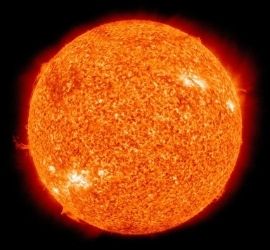Solar Minimum – Is a Mini Ice-Age Coming?
 A solar minimum is a reduced period of sunspot activity in the solar cycle. Some warn of a possible mini ice-age. However, scientists say it’s just business as usual.
A solar minimum is a reduced period of sunspot activity in the solar cycle. Some warn of a possible mini ice-age. However, scientists say it’s just business as usual.
We are normal people living in normal times. Therefore, you can expect normal things to happen. There are news tabloids reporting that a sun lockdown period is occurring. Or, that Earth is doomed from crazy weather, famine, and even earthquakes for some reason. At this point, anyway, you can relax. Nothing the Sun is currently doing is going to create a mini ice-age, famine, or earthquakes. As a matter of fact, the Sun is doing nothing unusual whatsoever. What is happening is a very normal period in the Sun’s 11-year cycle, and it’s called a solar minimum. Moreover, it’s nothing to be afraid of. Chances are you’ve already lived through several solar minimums without even noticing.
Sun Lockdown Period
Currently, we’re in solar cycle 24. We don’t know precisely when the next solar minimum will occur, but we can broadly predict it. Back in 2017, NASA noted that the solar minimum was expected in 2019-2020. In December of last year, the NOAA’s Solar Cycle 25 Prediction Panel narrowed it down further, stating that “solar minimum between cycles 24 and 25 will occur in April 2020 (+/- 6 months).” So, we’re either going through solar minimum already or are just about to do so. Here’s what that actually entails. The solar cycle is based on the Sun’s magnetic field, which flips around every 11 years, with its north and south magnetic poles switching places. (Source: sciencealert.com)
What is the Solar Minimum?
The Sun has a cycle that lasts between nine and 14 years. On average, a cycle typically lasts 11 years, on average. Right now, we’re in the low, inactive period. The peak of that cycle is called a solar maximum. A maximum is when the Sun produces more electrons and protons. This hyper-activity can be seen as huge solar flares and coronal mass ejections. From a visual perspective, the solar cycle is a sunspot cycle. This is because scientists can estimate where the Sun is in its cycle by counting sunspots on its surface.
It’s not known what drives these cycles. Recent research suggests it has to do with an 11.07-year planetary alignment. Regardless, when the magnetic field is at its weakest, it is known as the solar minimum. The Sun’s magnetic field controls solar activity like sunspots, coronal mass ejections, and solar flares. The cycle is detectable to us here on Earth as that activity changes. During solar minimum, there are minimal sunspots and flares. This gradually changes as the Sun ramps up to solar maximum. The magnetic field grows stronger, and sunspot and flare activity increases. Then, the cycle repeats subsiding again for the next solar minimum.
Solar cycles do not generally cause catastrophic events here on Earth. We may see more aurora activity during solar maximum since auroras are generated by solar activity. Increased solar activity can also affect radio communications and navigation satellites. People closely observing the Sun will see more sunspots during solar maximum. But usually, that’s about the extent of what the average person notices. However, that doesn’t mean catastrophic events can’t or won’t occur.
The Mauder Solar Minimum 1645-1715
Just as solar maximum sees many sunspots, the trough of solar minimum features zero sunspots—and that’s what’s going on now. However, it’s been continuing rather longer than expected, which means the Sun is in the midst of a particularly deep solar minimum. The most infamous happened between 1645 to 1715 when a “Maunder Minimum” saw a prolonged sunspot minimum when sunspots were very rare for an extended period. The current record-breaking solar minimum is part of a longer pattern of wax and wane; in fact, it’s believed that the Sun may have been in a magnetic lull for the last 9,000 years at least. (Source: forbes.com)
What is a Sunspot?
A sunspot is an area of intense magnetic activity on the surface of the Sun. It is often described as a storm that appears as an area of darkness. Sunspots indicate solar activity that is seen as solar flares and coronal mass ejections (CMEs). Although sunspots appear to us like tiny specks, they can be colossal in size. Sunspots have been continuously counted each day since 1838. This regular observation allowes solar scientists to describe a repeating pattern in the wax and wane of activity on the Sun’s surface—the solar cycle. (Source: ibid)
Solar Minimum Affect on Atmosphere
At solar minimum, solar ultraviolet radiation decreases. But, the effect of this primarily hits the stratosphere and higher altitudes. It causes Earth’s atmosphere to shrink slightly, which reduces drag on satellites. Conversely, the increase in UV radiation during solar maximum contributes to rainfall. However, the effect on temperature is negligible. There is also an increase in galactic cosmic rays from sources such as supernovae during solar minimum. Earth’s atmosphere protects us surface-dwellers from this radiation, which can increase the risk of cancer, but at higher altitudes, the radiation does pose an additional hazard to astronauts. “During solar minimum, the Sun’s magnetic field weakens and provides less shielding from these cosmic rays,” said astronomer Dean Pesnell of NASA’s Goddard Space Flight Center in 2017. “This can pose an increased threat to astronauts traveling through space.”
During solar minimum, the effects of Earth’s upper atmosphere on satellites in low Earth orbit changes too. Normally Earth’s upper atmosphere is heated and puffed up by ultraviolet radiation from the sun. Satellites in low Earth orbit experience friction as they skim through the outskirts of our atmosphere. This friction creates drag, causing satellites to lose speed over time and eventually fall back to Earth. Drag is a good thing, for space junk; natural and man-made particles floating in orbit around Earth. Drag helps keep low Earth orbit clear of debris. But during solar minimum, this natural heating mechanism subsides. Earth’s upper atmosphere cools and, to some degree, can collapse. Without a normal amount of drag, space junk tends to hang around. (Source: ibid)
Is a Solar Minimum Linked to the Dalton Minimum of 1816?
The link to dropping temperatures, earthquakes, and famine is tenuous at best. A tabloid called, The Sun cited unnamed NASA scientists fearing a repeat of an event known as the Dalton Minimum. This occurred around the early 19th century and saw an extreme period in Earth’s recorded history. The event centered around 1816 and was known as the Year Without a Summer. Temperatures dropped, crops failed, and many people around the world starved to death or died from the cold. However, it turns out that had nothing to do with the Sun’s activity. All those problems were caused by the colossal 1815 eruption of Mount Tambora in Indonesia. In addition, a 2013 paper found no link between solar activity and earthquakes.
Grand Solar Minimum
The most recent solar cycle was relatively quiet. Still, it led to a lot of fearmongering over an impending Grand Solar Minimum. This is a longer period of time spanning several cycles where even the maximums are subdued. Reports suggested global temperatures would plummet and a mini ice-age would occur. NASA clearly did not agree with this speculation:
“The warming caused by the greenhouse gas emissions from the human burning of fossil fuels is six times greater than the possible decades-long cooling from a prolonged Grand Solar Minimum. Even if a Grand Solar Minimum were to last a century, global temperatures would continue to warm. Because more factors than just variations in the Sun’s output change global temperatures on Earth, the most dominant of those today being the warming coming from human-induced greenhouse gas emissions.” NASA Global Climate Change Team.
Solar Minimum and Volcanic Activity
Some scientists have drawn a connection between solar minimum and volcanic activity. However, it’s a weak connection and different papers don’t agree. Regardless, we probably don’t have to worry about that, either. The Sun is significantly more active than it was during the Dalton Minimum, which saw very low sunspot activity from around 1790 to 1830. And, although cycle 24 was smaller than the previous few cycles, those cycles were unusually strong. Cycle 24 marked a return to a more normal activity level. So, the solar minimum we’re about to enter doesn’t look particularly unusual. According to the NOAA and NASA, and we can expect a similar intensity to the previous cycle, they noted in their prediction.
Up Next: What Is the Marginal Rate of Substitution (MRS)?
 The Marginal Rate of Substitution is the rate at which a consumer is willing to exchange units of good X for one more unit of good Y assuming both have the same utility.
The Marginal Rate of Substitution is the rate at which a consumer is willing to exchange units of good X for one more unit of good Y assuming both have the same utility.
In economics, the MRS is the amount of a good that a consumer is willing to consume in relation to another good. Of course, this assumes that the new good is equally satisfying. It’s used in indifference theory to analyze consumer behavior. The marginal rate of substitution is calculated between two goods placed on an indifference curve. The curve displays a frontier of utility for each combination of item X and item Y.



